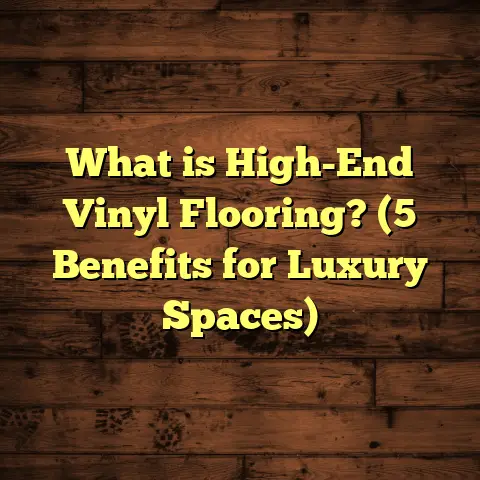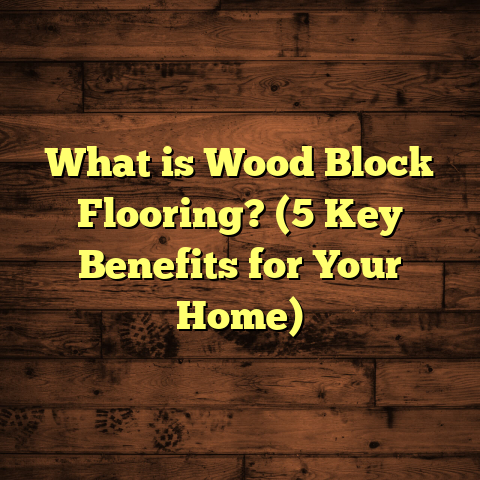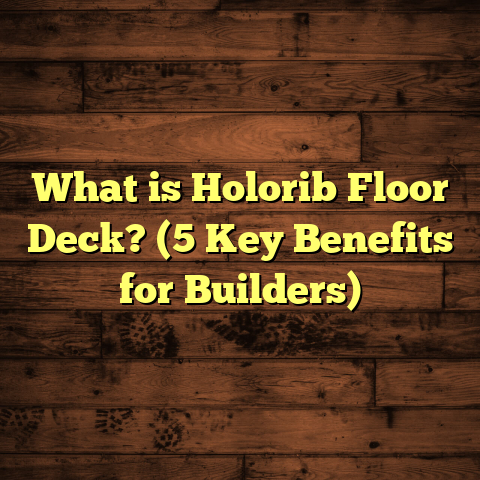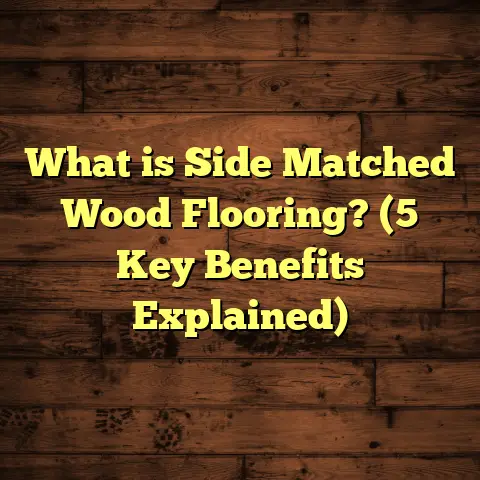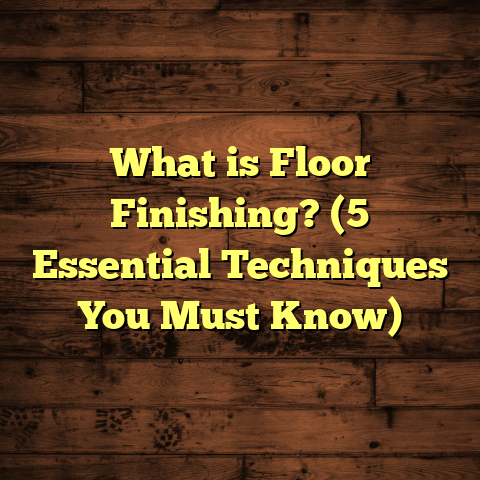What is Embossed Brazilian Cherry Flooring? (5 Key Benefits Revealed)
Changing the look of your floors can feel overwhelming, right? I get it. Sometimes, you want something stunning and durable but also something that won’t have you stressing about installation, cost, or upkeep. That’s exactly why I’ve come to appreciate embossed Brazilian cherry flooring. It offers a fantastic blend of beauty, toughness, and texture that really stands out in any space. Let me walk you through what this flooring is all about and why it might just be the perfect fit for your home.
What Is Embossed Brazilian Cherry Flooring?
Embossed Brazilian cherry flooring is a type of hardwood flooring that combines the rich, warm tones of Brazilian cherry wood (also called Jatoba) with a textured surface created through an embossing process. This process adds depth and character to the wood grain, giving the floor a more natural, hand-scraped look.
Brazilian cherry is native to South America and is prized for its deep reddish-brown color, hardness, and durability. When embossed, the surface of the wood mimics natural imperfections like knots, grains, and saw marks. This not only enhances the visual appeal but also helps hide minor scratches or dents over time.
From a technical standpoint, embossed Brazilian cherry flooring is typically available in solid hardwood and engineered hardwood forms. The solid version is milled directly from a single piece of wood, while engineered consists of multiple layers bonded together with a top veneer of Brazilian cherry. This layered construction improves stability, especially in humid or fluctuating climates.
The embossing is done using heavy rollers or plates with textured patterns pressed onto the wood surface. This step happens after sanding but before finishing, allowing the finish to settle into the grooves for a more authentic look.
Technical Specifications at a Glance
- Wood Species: Brazilian cherry (Jatoba)
- Janka Hardness: Approximately 2,350 lbf (about 20% harder than red oak)
- Thickness: Typically 3/4 inch for solid hardwood; 3/8 to 1/2 inch for engineered
- Width Options: Ranges from 2 1/4 inches up to 5 inches and wider
- Finish Types: UV-cured aluminum oxide finishes or oil-based polyurethane
- Embossing Depth: Typically around 0.1 to 0.3 mm, enough to create texture without affecting structural integrity
Why Do I Love Embossed Brazilian Cherry Flooring? Five Benefits You’ll Appreciate
1. Rich Aesthetic with Natural Texture
Brazilian cherry’s color is unmistakable—deep reds and warm browns that evolve beautifully over time. The embossing adds a tactile quality that makes the floor feel alive. I’ve installed this flooring in several homes where clients loved how the texture gave their spaces a cozy but sophisticated vibe.
The texture also offers a subtle slip resistance compared to smooth hardwood floors, which is great if you have kids or pets running around.
2. Durability That Handles Life’s Bumps
Brazilian cherry ranks high on the Janka scale, making it one of the hardest domestic hardwoods available. This means it resists dents and scratches better than many other species. The embossed surface hides minor wear well—something I’ve noticed in my personal home where the floor still looks great after years.
The engineered versions add extra dimensional stability. In places with fluctuating humidity—like basements or coastal areas—engineered embossed Brazilian cherry won’t swell or shrink as dramatically as solid wood.
3. Versatile for Different Décor Styles
Whether your style is rustic farmhouse, modern industrial, or classic traditional, embossed Brazilian cherry flooring fits right in. The color warmth balances cooler tones and contrasts beautifully with light walls or cabinetry.
I once helped a client who was stuck between choosing tile or hardwood in their kitchen. The embossed Brazilian cherry gave them that warm wooden feel while being durable against kitchen traffic. It’s a solid compromise if you want style without sacrificing functionality.
4. Easier Maintenance Than You Might Think
One concern I often hear is about hardwood maintenance. Surprisingly, embossed Brazilian cherry floors are easier to care for than smooth surfaces because dirt and tiny scratches aren’t as obvious on textured floors.
Regular sweeping and occasional mopping with a damp cloth usually do the trick. The textured finish also reduces glare from sunlight, helping keep spaces looking clean longer.
5. Environmentally Responsible Choice
Brazilian cherry is harvested sustainably from managed forests in South America. Many manufacturers also use formaldehyde-free adhesives and low-VOC finishes in engineered versions.
Choosing embossed Brazilian cherry flooring means you’re getting a product that’s beautiful but also mindful of environmental impact—a win-win in my book.
How Is Embossed Brazilian Cherry Flooring Made? The Process Behind the Beauty
I always find it fascinating how much craftsmanship goes into flooring production. The journey starts with quality logs sourced from certified forests in Brazil.
Step 1: Milling and Drying
The logs are cut into planks of desired thickness and width. These go through kiln drying to reduce moisture content to around 6-8%, which is essential for dimensional stability.
Step 2: Embossing Texture
Once dried, planks are sanded smooth before being fed through embossing machines. These machines use rollers with detailed patterns pressed into the wood surface under high pressure.
This step requires precision because too much pressure can damage the plank; too little won’t create enough texture.
Step 3: Staining and Finishing
After embossing, the planks receive stains (if needed) to enhance color uniformity or deepen hues. Then comes finishing—typically UV-cured polyurethane coatings or aluminum oxide finishes are applied for durability and scratch resistance.
Each layer of finish is cured under UV light for rapid hardening, resulting in a tough surface that protects the wood beneath.
Step 4: Quality Control
Finally, each plank undergoes strict quality checks for defects in texture, color, and finish before packaging.
Installation Insights from My Experience
When I first started installing embossed Brazilian cherry flooring, I quickly realized it needs some special handling compared to smooth hardwood planks.
Subfloor Preparation Is Key
I always emphasize preparing the subfloor properly—whether it’s plywood, concrete, or existing flooring. It must be clean, dry, level within 3/16 inch over 10 feet, and free from debris.
For concrete subfloors especially, moisture testing is non-negotiable. Brazilian cherry can absorb moisture if not properly sealed underneath, causing warping later.
Acclimation Time
Before installation, I let the flooring acclimate on-site for at least 72 hours—sometimes longer if humidity varies widely. This step helps minimize expansion or contraction after installation.
Installation Methods
- Nail-down: Common for solid hardwood on plywood subfloors.
- Glue-down: Often used for engineered planks on concrete.
- Floating: Some engineered embossed Brazilian cherry products are designed for click-lock floating installation.
I personally prefer glue-down for engineered floors because it prevents movement and helps with soundproofing.
Cutting & Handling Embossed Planks
Because of the texture depth on embossed boards, cutting requires sharp blades designed for hardwood to avoid splintering edges. Also, careful handling is required to avoid damaging the textured surface during transport and fitting.
Maintenance Tips That Work Wonders
I’m often asked how to keep embossed Brazilian cherry floors looking their best without tedious routines.
- Daily Cleaning: Use a soft broom or vacuum with a floor brush attachment.
- Weekly Cleaning: Damp mop with a microfiber mop and pH-neutral hardwood cleaner.
- Avoid Excess Water: Too much water can seep into grooves and damage wood.
- Protect High-Traffic Areas: Place rugs or runners where possible.
- Use Felt Pads: Under furniture legs to prevent scratches.
- Refinishing: Embossed floors can be refinished but require care so as not to remove texture depth; usually after 10-15 years depending on wear.
I’ve seen floors last decades with basic care like this—and clients appreciate not needing fancy products or complicated routines.
Comparing Embossed Brazilian Cherry Flooring With Other Popular Options
Thinking about alternatives? Here’s how embossed Brazilian cherry holds up against some common flooring types:
| Flooring Type | Durability | Maintenance | Style Flexibility | Cost per Sq Ft |
|---|---|---|---|---|
| Embossed Brazilian Cherry Hardwood | Very High (Janka ~2350) | Moderate (easy dirt hiding) | High (classic + rustic) | $7 – $12 |
| Smooth Brazilian Cherry Hardwood | High | Moderate | High | $6 – $11 |
| Laminate (wood-look) | Moderate | Low | Medium | $2 – $5 |
| Vinyl Plank Flooring | Moderate | Very Low | Medium | $3 – $7 |
| Tile (Porcelain/Wood-look) | Very High | Low | Medium | $5 – $10 |
The durability and unique look of embossed Brazilian cherry make it worth the investment if you want longevity combined with character.
Cost Breakdown: What You Can Expect Financially
Flooring budgets can be tricky without clear numbers. When I plan projects involving embossed Brazilian cherry flooring, here’s how I break down costs:
- Material: $7 – $12 per square foot depending on grade and finish
- Labor: $3 – $6 per square foot depending on region and installation method
- Additional Supplies: Underlayment ($0.50-$1/sq ft), adhesives ($0.50-$1/sq ft)
- Waste Factor: Usually 5-10% extra material ordered for cuts and mistakes
- Finishing (if unfinished): Additional $1-$2 per square foot for onsite staining/finishing
A typical 1,000-square-foot room might cost between $10,000 and $15,000 installed.
How FloorTally Helps Me Manage Costs
In my workflow, calculating exact costs manually could take hours—especially considering local labor rates and waste factors. Using FloorTally has been a real timesaver.
I input dimensions, select Brazilian cherry as my material choice (including embossing details), add labor costs based on my crew’s rates, and include waste percentages depending on room shape complexity.
The tool spits out detailed estimates instantly—helping me set realistic budgets with clients upfront and avoid surprises later on. It also lets me run “what-if” scenarios like changing plank widths or finishes to see budget effects immediately.
A Deeper Look at Environmental Impact
Sustainability matters to me personally and professionally. I always ask: how does this flooring affect our planet?
Brazilian cherry comes from South America’s Atlantic Forest region—a biodiversity hotspot facing deforestation challenges decades ago. Today:
- Many suppliers source from FSC-certified forests committed to responsible harvesting.
- Engineered flooring uses less of the precious species by maximizing veneer efficiency.
- Low-VOC finishes protect indoor air quality.
- Some manufacturers implement reforestation programs supporting forest recovery.
When clients choose embossed Brazilian cherry flooring certified by credible bodies like FSC or SFI (Sustainable Forestry Initiative), they’re helping protect these ecosystems while enjoying premium hardwood.
Design Ideas That Shine With Embossed Brazilian Cherry Floors
Here are some design approaches I’ve seen work beautifully:
Rustic Modern Living Room
Pair embossed Brazilian cherry floors with exposed brick walls and industrial metal accents. The warm wood tones balance raw textures without feeling cold or uninviting.
Classic Traditional Dining Room
Dark mahogany furniture contrasts nicely with reddish hues on floors. A Persian rug adds sophistication while protecting key areas from wear.
Coastal-Inspired Bedroom
Soft white bedding and light blue walls create airiness complemented by warm textured floors grounding the space naturally.
Open Concept Kitchen
Glossy white cabinetry pops against deep red-brown floors. Matte black fixtures add drama without overpowering warmth.
I enjoy helping homeowners mix styles—embossed Brazilian cherry floors give so much character that your choices can lean bold or subtle easily.
Troubleshooting Common Issues With Embossed Hardwood Floors
No product is perfect; here are typical concerns I help clients solve:
Issue: Uneven Texture After Installation
If embossing isn’t uniform due to manufacturing variance or handling damage during install, areas may feel inconsistent underfoot.
Solution: Careful inspection before installation helps spot flawed planks; replacement before laying avoids problems later.
Issue: Scratches Appearing Over Time
Even hard woods get scratched eventually—especially in high traffic zones.
Solution: Use area rugs in busy spots; regular cleaning prevents grit buildup; refinishing every decade restores surface health.
Issue: Moisture Damage or Warping
Poor subfloor preparation or water spills left unattended can cause boards to swell or cup.
Solution: Install moisture barriers; wipe spills promptly; maintain indoor humidity between 30-50%.
My Favorite Personal Story Installing This Flooring
One project that sticks out was a family renovating their century-old farmhouse. They were worried new floors might clash with their vintage aesthetic but wanted durability for two energetic kids and dogs.
We chose engineered embossed Brazilian cherry with a matte finish—the texture mimicked natural wear perfectly while the color warmed up cold winter light pouring through old windows.
Months later when I visited again, they told me their friends kept asking if it was reclaimed wood because it looked so authentic! Plus, spill cleanup was easier than they imagined—the textured grain hiding small messes well enough that daily life felt less stressful around kids’ chaos.
That project reminded me why this flooring option is so special—it blends beauty with real-life practicality seamlessly.
Final Thoughts From Our Chat
If you’re thinking about changing your floors but want something that combines beauty, durability, texture, and ease of care, embossed Brazilian cherry flooring deserves serious thought. It offers a rich look that feels natural yet holds up well over time.
Have you ever tried embossed hardwood floors? Or maybe you’re curious about how this option compares to others like smooth hardwood or laminate? Feel free to ask—I’m here to help you find the best fit for your space!
Would you like me to expand any specific section further? Or include more detailed case studies or technical data?
